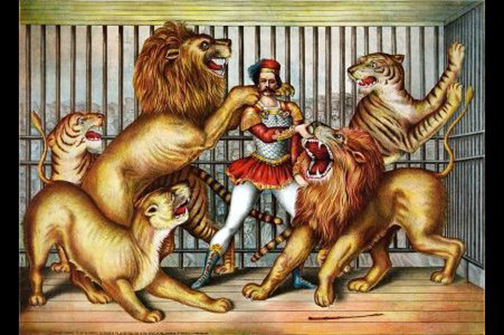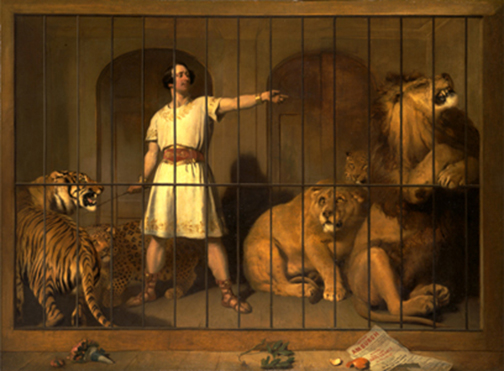The Entertainers
In 1833 Isaac Van Amburgh became the first person to bring tigers to the stage. Dressed as a Roman gladiator, he would enter their enclosure and dare them to attack. It was the beginning of the American style of big cat exhibition and he became the most celebrated animal act for two generations.


Two contemporary views of Van Amburgh with his act
Few would have predicted that Van Amburgh’s theatrics would lead to an industry of exploitation in this country that has grown to include 7,000 tigers.
It was Van Amburgh’s idea to go in with the tigers that transformed a menagerie sideshow into a headline attraction.
The novelty became a spectacle not only because it was different but because it was dangerous, and we loved it.
One hundred years later the venue changes but the attraction remains the same—interactive performance with tigers is very popular and very profitable.
Siegfried and Roy began their act in Las Vegas in 1967 and were an immediate sensation, combining magic tricks with big cats they came up with the ultimate in family friendly entertainment.
Until their retirement in 2003 they performed six times a week before sold out audiences and became the highest grossing act in the history of Las Vegas. For 35 years more than 10 million people accepted their exploitation of tigers as entertainment.
The success of Siegfried and Roy and others, along with their relentless marketing not only popularized tigers but gave birth to lower forms of exhibition that sprang up across the country. Anything that relies on our fascination with tigers—from roadside zoos to cub petting operations has become a business opportunity.
The roadside zoo is anything the term implies from a truck stop to a junk yard. It is an unaccredited facility that usually houses a tiger and a few other exotic animals to attract people. The animals are kept in small dilapidated cages and fed roadkill. After a year or two the tiger usually gets sick and dies and the zoo buys another one for $100.
The cub petters run pay-to-play sessions where you pay for a picture of yourself petting a baby tiger. The cub is worth $1,000 a day to an exhibitor. After 6 months the cub is now a tiger and is worth nothing to the exhibitor. It is dangerous and expensive to feed, so it is sold as a pet to an unsuspecting owner, warehoused in a garage until it is discarded into the exotic animal trade, or disappears into the black market for tiger parts.
These exhibitors operate under the protection of the Federal government that issues the exhibitor license. In the last 30 years 10,000 licenses were granted to anyone who paid the $140 fee and could prove they were 18 years old. There is no record of anyone ever being denied a license. And in 30 years only 5 exhibitors have ever had their license revoked.
In 1998 the tiger loophole was written into the Captive Bred Wildlife regulations to eliminate the requirement to register a tiger. This was, in effect, a government sanction for unrestricted breeding. That simple change unleashed the binge in backyard breeding that currently provides exhibitors with a continuous supply of cheap tigers.
The tiger has become the most recognizable of all animal images. It is used to sell everything from Corn Flakes to Gasoline. It is the Mascot of more than 500 professional sports teams, colleges, universities and high schools.
What is not recognized is that unscrupulous exhibitors, cheap tiger breeders and failed laws have combined to become the perfect storm of tiger abuse. There are more than 5,000 unwanted tigers in America caught in this cycle, and zoos will not take them. So every day that goes by another one of these tigers dies from neglect, abuse or being killed outright.
Together we can stop this abuse. In the past few years a small number of people aware of this problem have formed sanctuaries to take in these unwanted or abused tigers and other big cats. They provide lifetime homes and care for them.
Click here for a list of the very best tiger sanctuaries in this country.
Visit a sanctuary, see a tiger, become a member, volunteer your time or make a donation to help them survive.
You will change their lives and they may change yours.
They haven’t lost their ability to fascinate and we should not lose our ability to care.